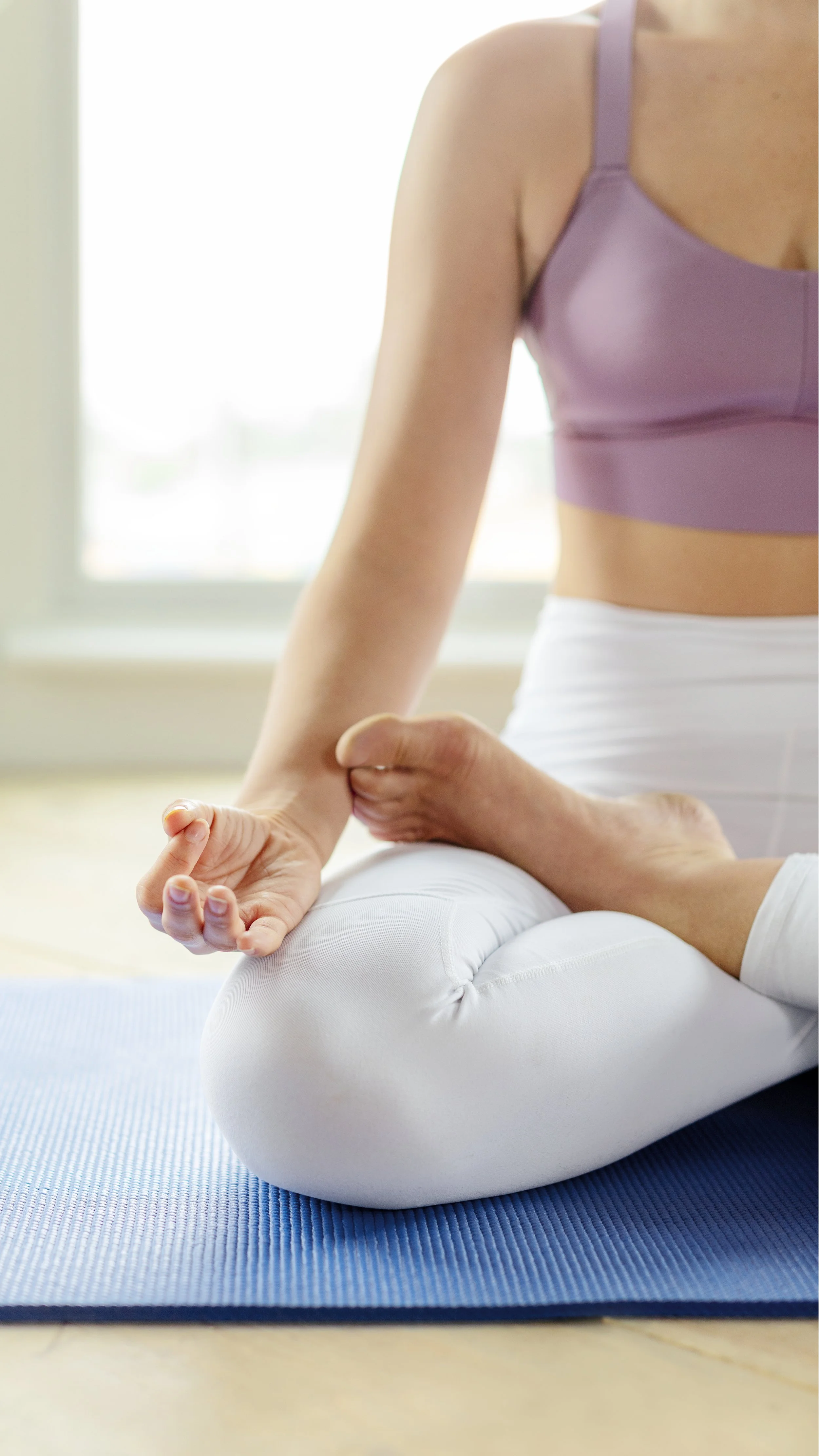Yoga or Pilates?
Here at WYLD, we encourage you to be an active participant in your wellness journey. Engaging in activities which promote strength and flexibility in your body can supercharge that journey, creating a life full of purpose, satisfaction, and increased energy for the things you love to do. So, let’s look at these two popular exercise modalities, to see what they can offer you.
The important balance between flexibility and strength is modelled beautifully by the spine: the design of the individual vertebrae allows for certain degrees of motion at each joint which, when combined, creates global bending and twisting. Muscles and ligaments both allow and limit this motion, so that we maintain control of the head above the pelvis. This balance is true of all the joints of the body: If muscles and ligaments are too tight, the body loses its full range of motion, becoming stiff and sore. If they are weak, they cannot support the joints, which can become hypermobile, leading to injury.
Unlike the ancient practice of Yoga, Pilates was created in the West during the 1920s by Joseph Pilates, as a form of rehabilitation. After an injury, muscles will often atrophy (shrink), from disuse. If you have ever broken a limb and had to wear a plaster cast or a moonboot, you probably noticed that the limb was smaller and weaker than its pair when the cast was removed weeks later. Pilates employs dynamic stretching to lengthen and strengthen the muscles, engaging the core abdominal muscles in resistance to the body’s own weight, encouraging muscle development that is balanced and proportional. There are various devices designed by Joseph Pilates (such as the Reformer) to challenge and support students, creating faster results.
While Pilates is certainly very popular, Yoga has become an institution. Despite the striking poses, endless choices of leggings, and even yogi singles dating sites (yup), the practice of yoga was originally intended to quieten the mind through focusing on the breath. The asanas (postures) are designed to create flexibility, strength, and balance. A Yoga session goes through a sequence of asanas that build on each other, creating heat in the body. A session typically culminates in “savasana” (corpse pose), lying on the back and allowing all the muscles to relax and the benefits of the practice to settle into the tissues.
There are countless offerings of yoga today, ranging from the traditional Ashtanga and Hatha, to more recent styles and fusions. Props such as blocks, straps and bolsters may be used to support and enhance your practice, and no matter your age, gender or ability, there is a class out there that caters to your needs.
Research indicates that both Yoga and Pilates may be beneficial in:
To sum up, both Yoga and Pilates are excellent additions to your wellness plan, and I highly recommend you try them both! Make sure your teacher is a registered instructor, this means they will have a sound anatomical understanding of the body, and the ability to modify their practice to best suit your needs. Resist the temptation to start out online! Non-virtual classes ensure that your instructor can correct your practice and save you from forming bad habits. It is also important not to jump ahead and try things you are not yet ready for, as this may lead to injury.
How Chiropractic Care Can Help
Chiropractic care is one of the least invasive but most effective treatments for tennis elbow. By ensuring that the spine is in its proper alignment it takes the pressure off the soft tissues that may be overworking due to the biomechanical changes that have taken place in the spine. This will help relax the muscles and take the pressure off the sciatic nerve which may help to alleviate pain.
What To Expect At Your First Chiropractic Visit
An initial Chiropractic exam for back pain will typically have three parts: a consultation, case history, and physical examination. Laboratory analysis and X-ray examination may be performed.
Consultation. The patient meets with the chiropractor and provides a brief synopsis of his or her lower back pain, such as:
Duration and frequency of symptoms
Description of the symptoms (e.g. burning, throbbing)
Areas of pain
What makes the pain feel better (e.g. sitting, stretching)
What makes the pain feel worse (e.g. standing, lifting).
Case history. The chiropractor identifies the area(s) of complaint and the nature of the back pain by asking questions and learning more about different areas of the patient's history, including:
Family history
Dietary habits
Past history of other treatments (chiropractic, osteopathic, medical and other)
Occupational history
Psychosocial history
Other areas to probe, often based on responses to above questions
Physical examination. A chiropractor may utilize a variety of methods to determine the spinal segments that require chiropractic treatments, including but not limited to static and motion palpation techniques determining spinal segments that are hypo mobile (restricted in their movement) or fixated. Depending on the results of the above examination, a chiropractor may use additional diagnostic tests, such as:
X-ray to locate subluxations (the altered position of the vertebra)
A device that detects the temperature of the skin in the paraspinal region to identify spinal areas with a significant temperature variance that requires manipulation.
Chiropractors are trained in a variety of methods to assess the underlying cause of the problem, including:
Evaluation and management services. Chiropractors are trained in examining the joints, bones, muscles and tendons of the spine, head, extremities and other areas of the body with the purpose of noting any misalignment, tenderness, asymmetry, defects or other problems.
Neurologic and other common physical examination procedures. Chiropractors are trained to perform a variety of neurologic tests (nerve root compression/tension, motor strength, coordination, deep tendon and pathological reflexes, etc.) and are skilled in performing orthopedic, cardiovascular and many other common examinations.
Specialised assessment. Chiropractors are trained to assess range of motion, stability, muscle strength, muscle tone and other assessments with the lower back.
Common diagnostic studies. Chiropractors are trained in use of diagnostic studies and tools such as radiography (X-rays), laboratory diagnostics and neurodiagnostics.
References
1. Klatt, M., & Moore, K. (2019). Beyond the East/West Dichotomy—The Course Yoga: Theory and Practice Conveys the Benefits of an Ayurvedic Lens for Global Health. Global Advances in Health and Latey, P. (2001). The Pilates method: history and philosophy. Journal of bodywork and movement Medicine, 8, 2164956119847931. https://pubmed.ncbi.nlm.nih.gov/31106037/
2. Lim, E. J., & Park, J. E. (2019). The effects of Pilates and yoga participant's on engagement in functional movement and individual health level. Journal of exercise rehabilitation, 15(4), 553–559. https://doi.org/10.12965/jer.1938280.140
3. Babayigit Irez, Gonul & Ozdemir, Recep Ali & Evin, Ruya & Irez, Salih & Korkusuz, Feza. (2011). Integrating Pilates Exercise into an Exercise Program for 65+ Year-Old Women to Reduce Falls. Journal of sports science & medicine. 10. 105-11. https://pubmed.ncbi.nlm.nih.gov/24149302/
4. Khalsa, S. B. S., Hickey-Schultz, L., Cohen, D., Steiner, N., & Cope, S. (2012). Evaluation of the mental health benefits of yoga in a secondary school: A preliminary randomized controlled trial. The journal of behavioral health services & research, 39(1), 80-90. https://pubmed.ncbi.nlm.nih.gov/21647811/
5. Ross, A., & Thomas, S. (2010). The health benefits of yoga and exercise: a review of comparison studies. The journal of alternative and complementary medicine, 16(1), 3-12. https://pubmed.ncbi.nlm.nih.gov/20105062/
6. Ross, A., Friedmann, E., Bevans, M., & Thomas, S. (2013). National survey of yoga practitioners:
Mental and physical health benefits. Complementary therapies in medicine, 21(4), 313-323. https://pubmed.ncbi.nlm.nih.gov/23876562/
7. Tolnai, N., Szabó, Z., Köteles, F., & Szabo, A. (2016). Physical and psychological benefits of once-a-week Pilates exercises in young
sedentary women: A 10-week longitudinal study. Physiology & behavior, 163, 211-218. https://pubmed.ncbi.nlm.nih.gov/27195456/
8. Mazzarino, M., Kerr, D., & Morris, M. E. (2018). Pilates program design and health benefits for pregnant women: A practitioners' survey. Journal of bodywork and movement therapies, 22(2), 411-417. https://pubmed.ncbi.nlm.nih.gov/29861243/
9. Suárez-Iglesias, D., Miller, K. J., Seijo-Martínez, M., & Ayán, C. (2019). Benefits of Pilates in Parkinson’s disease: a systematic review and meta-analysis. Medicina, 55(8), 476. https://pubmed.ncbi.nlm.nih.gov/31412676/






